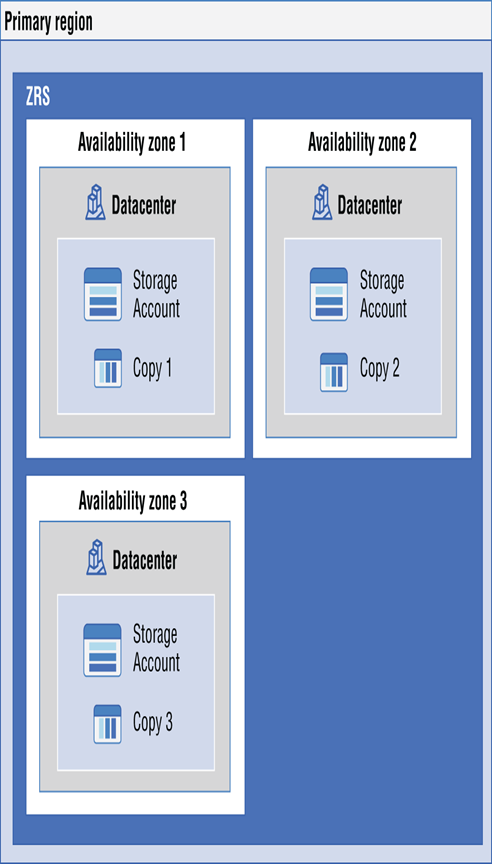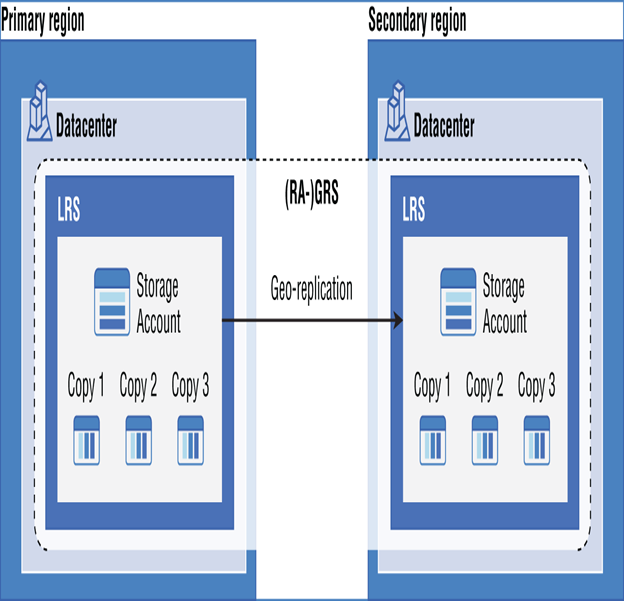Remember that we discussed the concept of availability zones in Chapter 5, “Network Traffic Management”? In the case of zone redundant storage (ZRS), data is synchronously replicated across three storage clusters. These storage clusters are located in different availability zones. Depending upon the region, two or three availability zones will be hosting the storage clusters. The separation between these zones will overcome the datacenter failure issue that you saw in the case of LRS. Thus, enabling ZRS replication ensures that your data is accessible even if one zone is offline.
Now there are two downsides here. The first is that ZRS is not available in all regions; however, Microsoft is continually adding more regions to the list. Second, if an entire region comes down, ZRS cannot protect your data as all the zones hosting the storage cluster will be offline. Nonetheless, this is applicable only if all the zones are affected. Figure 6.2 is a pictorial representation of ZRS.

FIGURE 6.2 Zone redundant storage
The durability offered by ZRS is higher than LRS, and the figure is 99.999999999999 percent (12 nines) over a given year.
Georedundant Storage
To overcome a regional wide outage, Microsoft offers GRS. In georedundant storage (GRS), your data is replicated to a secondary region. Ideally, the secondary region will be hundreds of miles away from the primary region. The secondary region is selected by Azure based on the regional pairs. This isolation ensures that if the primary is affected due to any calamity, it shouldn’t affect the secondary. Cost-wise, GRS is more expensive than ZRS and LRS; with the increased cost comes more data durability. GRS offers a durability of 99.9999999999999999 percent (16 nine) over a given year.
GRS offers two variants.
GRS This method replicates the data to the secondary region; however, the data in the secondary is not readable. The data can be read only if a failover is initiated to the secondary region. The failover can be initiated by the customer manually or by Microsoft in the case of a regional outage.
Read-Access Geo Redundant Storage (RA-GRS) In RA-GRS, the replication works in the same way as GRS. The key difference here is that you have the provision to read from the secondary region regardless of whether a failover is initiated. The secondary region is always available for read requests.
If you have GRS or RA-GRS enabled, in the primary region you will have three copies. In the primary region, the replication is achieved using LRS, where the copies are within the same datacenter. Then this data is asynchronously replicated to the secondary region. In the secondary region also, you will have three copies of the data, replicated using LRS.
Figure 6.3 shows how the data is replicated in the primary and secondary using GRS/RA-GRS.

FIGURE 6.3 Georedundant storage
Since you are using LRS as the replication method, if both the datacenters in the primary and secondary region go offline, then your data will be inaccessible. This scenario is very unlikely; however, Azure an additional redundancy option called geo-zone-redundant storage.



